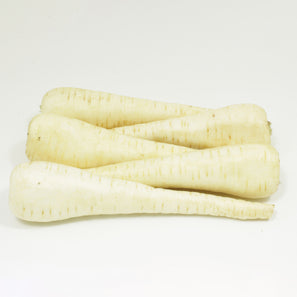GLADIATOR
Product Description:
| Soil Temp for Germ | 55–75°F |
| Seed Depth | ½" |
| Seed Spacing | ½" |
| Days to Emergence | 15–28 |
| Thin Plants to | 3–4" |
| Row Spacing | 12–18" |
| Fertilizer Needs | Low |
| Minimum Germination | 65% |
| Seeds per Gram | ≈ 175 |
| Seed Life | 1 year |
Pastinaca sativa This hearty, sweet vegetable is often overlooked by gardeners, yet it deserves a place in both spring and fall plantings. A rich source of copper, this trace element is said to support hemoglobin formation for healthy bones, blood vessels, and nerves.
Days to maturity are calculated from date of direct seeding.
Culture
• Parsnips perform best in deeply worked, well-composted, loose soil with a pH of 6.0-7.0
• High nitrogen fertilizer or manure can cause roots to fork and become hairy
• Avoid compacting the soil as parsnips are deeply rooted
• Keep well watered through the growing season
Direct Sowing
• Dig a shallow furrow and lightly cover seed with soil, vermiculite or sifted compost
• Water evenly and regularly to prevent soil crusting
• Row cover beds when soil temperatures are cool and to help prevent soil crusting
• Thin when plants are 4 inches tall
• Savvy gardeners plant radish seed in the furrow with parsnips to help break the soil surface for slower-growing parsnips
• Sow mid-June—July for a fall/winter crop
Insects & Diseases
• Common insects: Carrot rust fly maggots
• Insect control: Reemay or Summer Insect Barrier, until tops are 3-4 inches tall
• Common diseases: Celery blight
• Disease prevention: Keep well watered and a 3-4 year crop rotation
Harvest & Storage
• Flavor is enhanced after a couple of frosts
• Roots can be dug any time at maturity through winter as needed
• Protect from freezing with a weed-free straw mulch
• Store at 36°F and 95% humidity
KEY TO PARSNIP DISEASE RESISTANCE AND TOLERANCE
HR indicates high resistance.
IR indicates intermediate resistance.
BC | Black Canker




